Cesare Stefanini
Lightweight Kinematic and Static Modeling of Cable-Driven Continuum Robots via Actuation-Space Energy Formulation
Sep 04, 2025Abstract:Continuum robots, inspired by octopus arms and elephant trunks, combine dexterity with intrinsic compliance, making them well suited for unstructured and confined environments. Yet their continuously deformable morphology poses challenges for motion planning and control, calling for accurate but lightweight models. We propose the Lightweight Actuation Space Energy Modeling (LASEM) framework for cable driven continuum robots, which formulates actuation potential energy directly in actuation space. LASEM yields an analytical forward model derived from geometrically nonlinear beam and rod theories via Hamilton's principle, while avoiding explicit modeling of cable backbone contact. It accepts both force and displacement inputs, thereby unifying kinematic and static formulations. Assuming the friction is neglected, the framework generalizes to nonuniform geometries, arbitrary cable routings, distributed loading and axial extensibility, while remaining computationally efficient for real-time use. Numerical simulations validate its accuracy, and a semi-analytical iterative scheme is developed for inverse kinematics. To address discretization in practical robots, LASEM further reformulates the functional minimization as a numerical optimization, which also naturally incorporates cable potential energy without explicit contact modeling.
A Survey on Soft Robot Adaptability: Implementations, Applications, and Prospects
Jun 24, 2025Abstract:Soft robots, compared to rigid robots, possess inherent advantages, including higher degrees of freedom, compliance, and enhanced safety, which have contributed to their increasing application across various fields. Among these benefits, adaptability is particularly noteworthy. In this paper, adaptability in soft robots is categorized into external and internal adaptability. External adaptability refers to the robot's ability to adjust, either passively or actively, to variations in environments, object properties, geometries, and task dynamics. Internal adaptability refers to the robot's ability to cope with internal variations, such as manufacturing tolerances or material aging, and to generalize control strategies across different robots. As the field of soft robotics continues to evolve, the significance of adaptability has become increasingly pronounced. In this review, we summarize various approaches to enhancing the adaptability of soft robots, including design, sensing, and control strategies. Additionally, we assess the impact of adaptability on applications such as surgery, wearable devices, locomotion, and manipulation. We also discuss the limitations of soft robotics adaptability and prospective directions for future research. By analyzing adaptability through the lenses of implementation, application, and challenges, this paper aims to provide a comprehensive understanding of this essential characteristic in soft robotics and its implications for diverse applications.
ZodiAq: An Isotropic Flagella-Inspired Soft Underwater Drone for Safe Marine Exploration
Mar 25, 2025

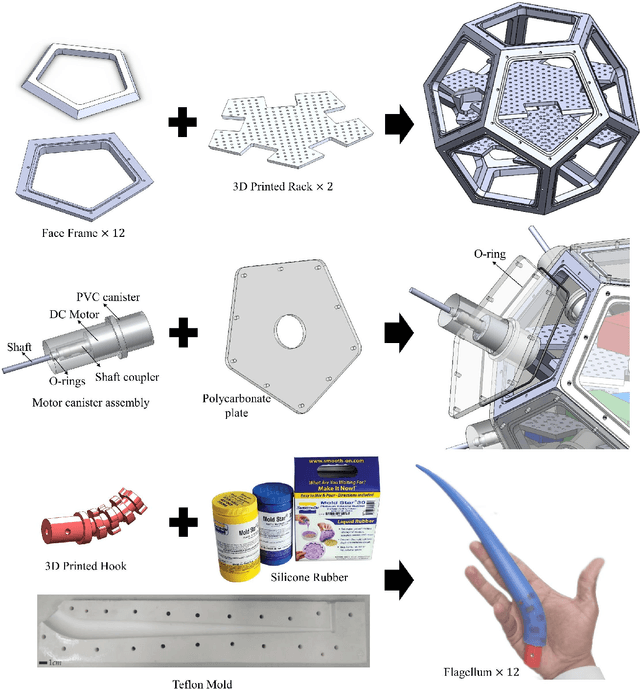

Abstract:The inherent challenges of robotic underwater exploration, such as hydrodynamic effects, the complexity of dynamic coupling, and the necessity for sensitive interaction with marine life, call for the adoption of soft robotic approaches in marine exploration. To address this, we present a novel prototype, ZodiAq, a soft underwater drone inspired by prokaryotic bacterial flagella. ZodiAq's unique dodecahedral structure, equipped with 12 flagella-like arms, ensures design redundancy and compliance, ideal for navigating complex underwater terrains. The prototype features a central unit based on a Raspberry Pi, connected to a sensory system for inertial, depth, and vision detection, and an acoustic modem for communication. Combined with the implemented control law, it renders ZodiAq an intelligent system. This paper details the design and fabrication process of ZodiAq, highlighting design choices and prototype capabilities. Based on the strain-based modeling of Cosserat rods, we have developed a digital twin of the prototype within a simulation toolbox to ease analysis and control. To optimize its operation in dynamic aquatic conditions, a simplified model-based controller has been developed and implemented, facilitating intelligent and adaptive movement in the hydrodynamic environment. Extensive experimental demonstrations highlight the drone's potential, showcasing its design redundancy, embodied intelligence, crawling gait, and practical applications in diverse underwater settings. This research contributes significantly to the field of underwater soft robotics, offering a promising new avenue for safe, efficient, and environmentally conscious underwater exploration.
Boundary Control Behaviors of Multiple Low-cost AUVs Using Acoustic Communication
Nov 28, 2024



Abstract:This study presents acoustic-based methods for the control of multiple autonomous underwater vehicles (AUV). This study proposes two different models for implementing boundary and path control on low-cost AUVs using acoustic communication and a single central acoustic beacon. Two methods are presented: the Range Variation-Based (RVB) model completely relies on range data obtained by acoustic modems, whereas the Heading Estimation-Based (HEB) model uses ranges and range rates to estimate the position of the central boundary beacon and perform assigned behaviors. The models are tested on two boundary control behaviors: Fencing and Milling. Fencing behavior ensures AUVs return within predefined boundaries, while Milling enables the AUVs to move cyclically on a predefined path around the beacon. Models are validated by successfully performing the boundary control behaviors in simulations, pool tests, including artificial underwater currents, and field tests conducted in the ocean. All tests were performed with fully autonomous platforms, and no external input or sensor was provided to the AUVs during validation. Quantitative and qualitative analyses are presented in the study, focusing on the effect and application of a multi-robot system.
S2C2A: A Flexible Task Space Planning and Control Strategy for Modular Soft Robot Arms
Oct 04, 2024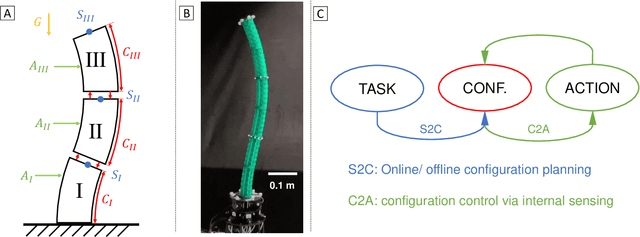
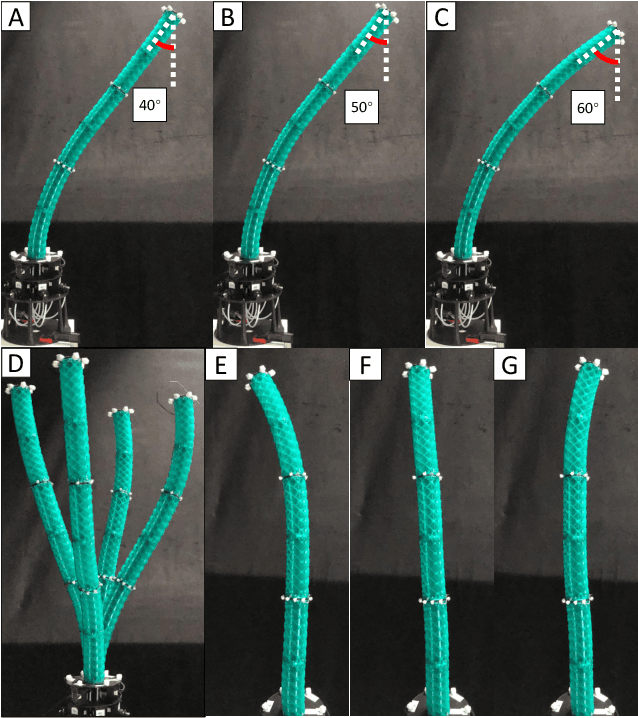
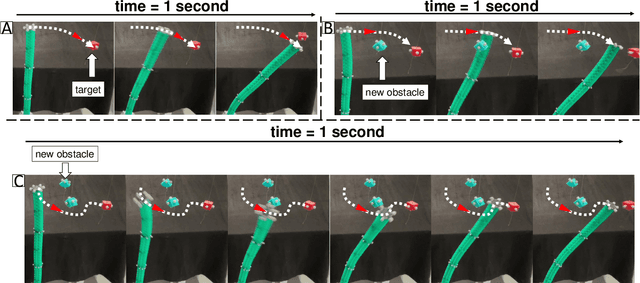
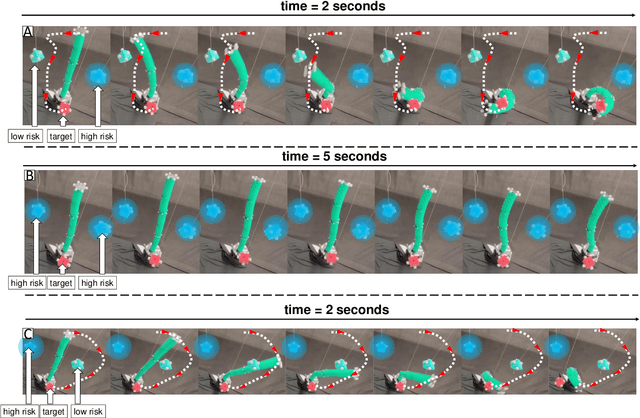
Abstract:Modular soft robot arms (MSRAs) are composed of multiple independent modules connected in a sequence. Due to their modular structure and high degrees of freedom (DOFs), these modules can simultaneously bend at different angles in various directions, enabling complex deformation. This capability allows MSRAs to perform more intricate tasks than single module robots. However, the modular structure also induces challenges in accurate planning, modeling, and control. Nonlinearity, hysteresis, and gravity complicate the physical model, while the modular structure and increased DOFs further lead to accumulative errors along the sequence. To address these challenges, we propose a flexible task space planning and control strategy for MSRAs, named S2C2A (State to Configuration to Action). Our approach formulates an optimization problem, S2C (State to Configuration planning), which integrates various loss functions and a forward MSRA model to generate configuration trajectories based on target MSRA states. Given the model complexity, we leverage a biLSTM network as the forward model. Subsequently, a configuration controller C2A (Configuration to Action control) is implemented to follow the planned configuration trajectories, leveraging only inaccurate internal sensing feedback. Both a biLSTM network and a physical model are utilized for configuration control. We validated our strategy using a cable-driven MSRA, demonstrating its ability to perform diverse offline tasks such as position control, orientation control, and obstacle avoidance. Furthermore, our strategy endows MSRA with online interaction capability with targets and obstacles. Future work will focus on addressing MSRA challenges, such as developing more accurate physical models and reducing configuration estimation errors along the module sequence.
Wireless teleoperation of HSURF artificial fish in complex paths
Jul 06, 2024Abstract:In this paper we show the application of the new robotic multi-platform system HSURF to a specific use case of teleoperation, aimed at monitoring and inspection. The HSURF system, consists of 3 different kinds of platforms: floater, sinker and robotic fishes. The collaborative control of the 3 platforms allows a remotely based operator to control the fish in order to visit and inspect several targets underwater following a complex trajectory. A shared autonomy solution shows to be the most suitable, in order to minimize the effect of limited bandwidth and relevant delay intrinsic to acoustic communications. The control architecture is described and preliminary results of the acoustically teleoperated visits of multiple targets in a testing pool are provided.
Data-driven Explainable Controller for Soft Robots based on Recurrent Neural Networks
Jun 06, 2024Abstract:The nonlinearity and hysteresis of soft robot motions have posed challenges in accurate soft robot control. Neural networks, especially recurrent neural networks (RNNs), have been widely leveraged for this issue due to their nonlinear activation functions and recurrent structures. Although they have shown satisfying accuracy in most tasks, these black-box approaches are not explainable, and hence, they are unsuitable for areas with high safety requirements, like robot-assisted surgery. Based on the RNN controllers, we propose a data-driven explainable controller (DDEC) whose parameters can be updated online. We discuss the Jacobian controller and kinematics controller in theory and demonstrate that they are only special cases of DDEC. Moreover, we utilize RNN, the Jacobian controller, the kinematics controller, and DDECs for trajectory following tasks. Experimental results have shown that our approach outperforms the other controllers considering trajectory following errors while being explainable. We also conduct a study to explore and explain the functions of each DDEC component. This is the first interpretable soft robot controller that overcomes the shortcomings of both NN controllers and interpretable controllers. Future work may involve proposing different DDECs based on different RNN controllers and exploiting them for high-safety-required applications.
Animal Behavior Analysis Methods Using Deep Learning: A Survey
May 22, 2024



Abstract:Animal behavior serves as a reliable indicator of the adaptation of organisms to their environment and their overall well-being. Through rigorous observation of animal actions and interactions, researchers and observers can glean valuable insights into diverse facets of their lives, encompassing health, social dynamics, ecological relationships, and neuroethological dimensions. Although state-of-the-art deep learning models have demonstrated remarkable accuracy in classifying various forms of animal data, their adoption in animal behavior studies remains limited. This survey article endeavors to comprehensively explore deep learning architectures and strategies applied to the identification of animal behavior, spanning auditory, visual, and audiovisual methodologies. Furthermore, the manuscript scrutinizes extant animal behavior datasets, offering a detailed examination of the principal challenges confronting this research domain. The article culminates in a comprehensive discussion of key research directions within deep learning that hold potential for advancing the field of animal behavior studies.
Soft Contact Simulation and Manipulation Learning of Deformable Objects with Vision-based Tactile Sensor
May 12, 2024



Abstract:Deformable object manipulation is a classical and challenging research area in robotics. Compared with rigid object manipulation, this problem is more complex due to the deformation properties including elastic, plastic, and elastoplastic deformation. In this paper, we describe a new deformable object manipulation method including soft contact simulation, manipulation learning, and sim-to-real transfer. We propose a novel approach utilizing Vision-Based Tactile Sensors (VBTSs) as the end-effector in simulation to produce observations like relative position, squeezed area, and object contour, which are transferable to real robots. For a more realistic contact simulation, a new simulation environment including elastic, plastic, and elastoplastic deformations is created. We utilize RL strategies to train agents in the simulation, and expert demonstrations are applied for challenging tasks. Finally, we build a real experimental platform to complete the sim-to-real transfer and achieve a 90% success rate on difficult tasks such as cylinder and sphere. To test the robustness of our method, we use plasticine of different hardness and sizes to repeat the tasks including cylinder and sphere. The experimental results show superior performances of deformable object manipulation with the proposed method.
A Novel and Accurate BiLSTM Configuration Controller for Modular Soft Robots with Module Number Adaptability
Jan 19, 2024Abstract:Modular soft robots have shown higher potential in sophisticated tasks than single-module robots. However, the modular structure incurs the complexity of accurate control and necessitates a control strategy specifically for modular robots. In this paper, we introduce a data collection strategy and a novel and accurate bidirectional LSTM configuration controller for modular soft robots with module number adaptability. Such a controller can control module configurations in robots with different module numbers. Simulation cable-driven robots and real pneumatic robots have been included in experiments to validate the proposed approaches, and we have proven that our controller can be leveraged even with the increase or decrease of module number. This is the first paper that gets inspiration from the physical structure of modular robots and utilizes bidirectional LSTM for module number adaptability. Future work may include a planning method that bridges the task and configuration spaces and the integration of an online controller.
 Add to Chrome
Add to Chrome Add to Firefox
Add to Firefox Add to Edge
Add to Edge